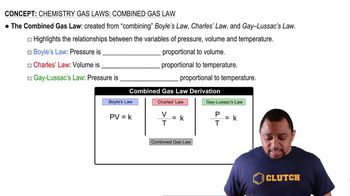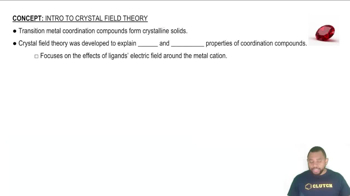Ch.21 - Transition Elements and Coordination Chemistry
Chapter 21, Problem 137
The complete reaction of 2.60 g of chromium metal with 50.00 mL of 1.200 M H2SO4 in the absence of air gave a blue solution and a colorless gas that was collected at 25 °C and a pressure of 735 mm Hg. (a) Write a balanced net ionic equation for the reaction. (b) How many liters of gas were produced? (c) What is the pH of the solution? (d) Describe the bonding in the blue-colored ion, using both the crystal field theory and the valence bond theory. Include the appropriate crystal field d-orbital energy-level diagram and the valence bond orbital diagram. Identify the hybrid orbitals used in the valence bond description.
 Verified step by step guidance
Verified step by step guidance1
Step 1: Identify the reactants and products. Chromium (Cr) reacts with sulfuric acid (H2SO4) to produce chromium ions, sulfate ions, and hydrogen gas (H2). The blue solution indicates the presence of a chromium ion complex.
Step 2: Write the balanced net ionic equation. Focus on the species that change oxidation states. Chromium metal (Cr) is oxidized to Cr^3+ ions, and H+ ions from H2SO4 are reduced to H2 gas. The net ionic equation is: Cr(s) + 6H+(aq) -> Cr^3+(aq) + 3H2(g).
Step 3: Calculate the moles of chromium and sulfuric acid. Use the molar mass of chromium to find moles from 2.60 g. For H2SO4, use the concentration and volume to find moles: moles = Molarity x Volume (in liters).
Step 4: Determine the limiting reactant. Compare the mole ratio from the balanced equation to the moles calculated. The limiting reactant will determine the amount of gas produced.
Step 5: Use the ideal gas law to find the volume of gas produced. Use the equation PV = nRT, where P is pressure (converted to atm), V is volume, n is moles of gas, R is the ideal gas constant, and T is temperature in Kelvin. Solve for V.
Key Concepts
Here are the essential concepts you must grasp in order to answer the question correctly.
Net Ionic Equations
A net ionic equation represents the chemical species that are involved in a reaction, excluding spectator ions. It highlights the actual chemical change occurring in the solution. To write a net ionic equation, one must first write the balanced molecular equation, then dissociate the soluble ionic compounds into their respective ions, and finally eliminate the spectator ions to focus on the species that undergo a change.
Recommended video:
Guided course

Net Ionic Equations
Gas Laws and Volume Calculations
Gas laws, particularly the Ideal Gas Law (PV=nRT), relate the pressure, volume, temperature, and number of moles of a gas. In this context, the volume of gas produced can be calculated using the known pressure, temperature, and the number of moles derived from the stoichiometry of the reaction. Understanding these relationships is crucial for determining the volume of gas generated in the reaction.
Recommended video:
Guided course

Combined Gas Law
Crystal Field Theory and Valence Bond Theory
Crystal Field Theory (CFT) explains the electronic structure of transition metal complexes by considering the effect of surrounding ligands on the d-orbitals of the metal ion. It describes how the energy levels of these orbitals split in the presence of ligands. Valence Bond Theory (VBT) complements this by focusing on the overlap of atomic orbitals to form bonds, including hybridization, which describes the mixing of atomic orbitals to form new hybrid orbitals that participate in bonding.
Recommended video:
Guided course

The study of ligand-metal interactions helped to form Ligand Field Theory which combines CFT with MO Theory.
Related Practice
